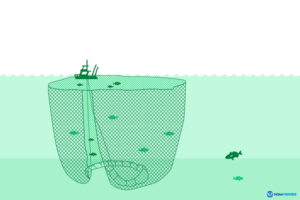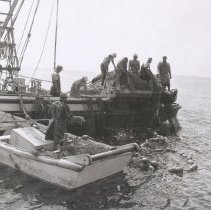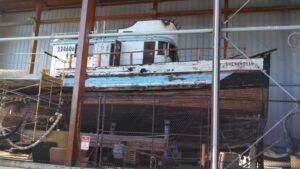PURSE SEINE FISHING IN THE NORTHWEST
Purse seine fishing has been a important part of Northwest history for a century. Purse seine fishing involves releasing one end of a net off the stern of fishing boats with a smaller power skiff attached to the other end. The purpose is to locate salmon and form a circle around them. The two ends of the net are brought together when the power skiff pulls up to the larger fishing boat. The net is hauled to the deck piling it on the stern until the final net is left, hopefully with salmon caught inside. That portion is lifted on deck and the fish poured into the hold of the fishing boat. If there are too many fish to lift from the water, the salmon are lifted out of the net with a net scoop. The name purse seine comes from the fact that the net has floating corks on top and lead weights on the bottom with purse lines that allow the net to be cinched up, like a purse so no fish can escape. Purse seining involves hard labor of hand pulling the net to bring it to the boat until the fish could be lifted on the boat. In the 1950’s the Puretic power block was introduced to purse seine fishing which could pull the net to the fishing boat with hydraulic power. Another innovation was a drum mounted on the stern of the boat and used to pull in the net over a revolving drum under power.
net is hauled to the deck piling it on the stern until the final net is left, hopefully with salmon caught inside. That portion is lifted on deck and the fish poured into the hold of the fishing boat. If there are too many fish to lift from the water, the salmon are lifted out of the net with a net scoop. The name purse seine comes from the fact that the net has floating corks on top and lead weights on the bottom with purse lines that allow the net to be cinched up, like a purse so no fish can escape. Purse seining involves hard labor of hand pulling the net to bring it to the boat until the fish could be lifted on the boat. In the 1950’s the Puretic power block was introduced to purse seine fishing which could pull the net to the fishing boat with hydraulic power. Another innovation was a drum mounted on the stern of the boat and used to pull in the net over a revolving drum under power.
From the time I was in the ninth grade through college I worked each summer on as a skiff man on salmon purse seine boats. The usual season involved leaving for Alaska to fish at the end of May and returning in mid June to fish in the Sound until school began in September. I’ve written on several past occasions about my experience working on salmon purse seine fishing boats. Our family grocery store was significantly dependent upon the fishing fleet in Anacortes trading at our  family grocery store. Each summer the fishing fleet in Anacortes would leave for fishing in Alaska. They would buy groceries for the time they were in Alaska. The fleet would return after several weeks of fishing in Alaska to fish in the San Juan Islands. Each week they returned to Anacortes for the weekend and would buy groceries for the following week of fishing. The great majority of the fishing boats traded at our grocery store in Anacortes. See my description of this annual event at: https://paulluverajournalonline.com/weblog/2013/12/luveras-grocery-store-salmon-fishing-in-anacortes
family grocery store. Each summer the fishing fleet in Anacortes would leave for fishing in Alaska. They would buy groceries for the time they were in Alaska. The fleet would return after several weeks of fishing in Alaska to fish in the San Juan Islands. Each week they returned to Anacortes for the weekend and would buy groceries for the following week of fishing. The great majority of the fishing boats traded at our grocery store in Anacortes. See my description of this annual event at: https://paulluverajournalonline.com/weblog/2013/12/luveras-grocery-store-salmon-fishing-in-anacortes
I’ve also written about my experience fishing generally See https://paulluverajournalonline.com/weblog/2008/05/purse-seine-fish I’ve written about the benefit from fishing as a result of my experiences and from my relationship with the men on the crew. When I began fishing there were seven or more crew on a boat less then fifty feet long. You all slept on bunks below deck together. You ate at a small galley together and you spent you working days in close confinement. The crew usually consisted of older men with one or two new younger ones my age. While many were from Yugoslavia and lacking in formal education, they had a lot to teach about wisdom, hard work as well as maturity. As a result, I consider my years on the fishing boats as important as college education regarding growing mature and learning to get along with others. One summer I fished on a purse seine boat from Gig Harbor, “The Welcome” whose captain was John Stanich of Gig Harbor. See https://paulluverajournalonline.com/weblog/2021/10/the-gift-of-working-on-salmon-purse-seine-boats
Gary Keister and I are long time friends who attended Anacortes High School and were both involved in purse seine fishing. Gary became a skipper of a purse seine boat at an early age and has written a book about it. See “Along the Cork Line” available from Amazon. It is a personal account by Gary about a time when commercial salmon fishing in the Puget Sound and Alaska was at its peak. He began helping on seine boats as as an eight year old cabin boy. He eventually became a skipper and ultimately a fish processor, making a living. For more information about the experience of working on a salmon purse seine boat I recommend Gary’s book. Another book with stories about life aboard a purse seine boat is “The Big Run: Life Aboard a Salmon Seiner” by Ray Fadich, it was published in 2020 as a memoir of his experiences in 1958 as a crew man aboard the purse seine vessel “The Emancipator.” That year was the year of a great salmon run in Puget Sound. I fished that year and remember being able to buy a car with what I made. In this memoir of the 1958 sockeye fishing season aboard The Emancipator Ray Fadich describes in detail the disappointment and joy he and his crewmates experienced as they vied with weather, competing boats, and hard work. Anacortes native, Bret Lunsford has written an excellent book “Croatian Fishing Families of Anacortes” about the arrival Croatian immigrants in Anacortes about 1914 and their role in purse seine fishing.
 Gig Harbor has had a major role in purse seine fishing just as Anacortes has had a significant role. In fact, the Gig Harbor Museum has a restoration project involving the vessel Shenandoah. Built in 1925 this 65 foot purse seiner was donated to the Museum in 2000. The vessel was owned by Tony Janovich, who donated it to the Museum shortly after his retirement from fishing. It was built at the Gig Harbor Skansie Shipyard in the winter of 1925. It was built for Pasco Dorotich, a pioneer Gig Harbor fishing boat owner and skipper. She was originally powered by a 65 h.p. Atlas Imperial diesel, a somewhat advanced conception of marine power for fishing vessels in 1925. The Shenandoah was operated almost exclusively at the Salmon Banks in the San Juan Islands but she also made several trips to Alaska in her early days. Gig Harbor’s involvement in purse seine fishing is shown by the fact it even offers a course to train purse seine crewman for the job. The Gig Harbor Boat Shop and Washington Sea Grant have partnered in developing a new Purse Seine Crew-Member Training Program. The six-day program was first be offered in the fall of 2021 in Gig Harbor. Program participants will be provided with a Crew Training Certificate and list of employment opportunities upon course completion. Gig Harbor remains a purse seine fishing town.
Gig Harbor has had a major role in purse seine fishing just as Anacortes has had a significant role. In fact, the Gig Harbor Museum has a restoration project involving the vessel Shenandoah. Built in 1925 this 65 foot purse seiner was donated to the Museum in 2000. The vessel was owned by Tony Janovich, who donated it to the Museum shortly after his retirement from fishing. It was built at the Gig Harbor Skansie Shipyard in the winter of 1925. It was built for Pasco Dorotich, a pioneer Gig Harbor fishing boat owner and skipper. She was originally powered by a 65 h.p. Atlas Imperial diesel, a somewhat advanced conception of marine power for fishing vessels in 1925. The Shenandoah was operated almost exclusively at the Salmon Banks in the San Juan Islands but she also made several trips to Alaska in her early days. Gig Harbor’s involvement in purse seine fishing is shown by the fact it even offers a course to train purse seine crewman for the job. The Gig Harbor Boat Shop and Washington Sea Grant have partnered in developing a new Purse Seine Crew-Member Training Program. The six-day program was first be offered in the fall of 2021 in Gig Harbor. Program participants will be provided with a Crew Training Certificate and list of employment opportunities upon course completion. Gig Harbor remains a purse seine fishing town.
I owe a lot to commercial salmon fishing on purse seine boats and that makes Gig Harbor special to me.
